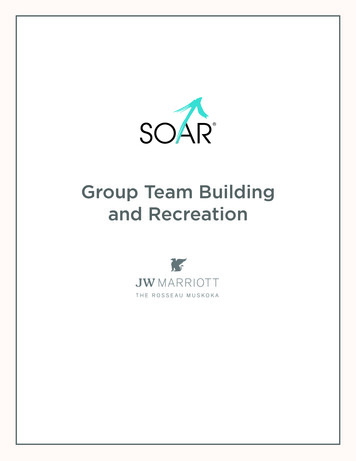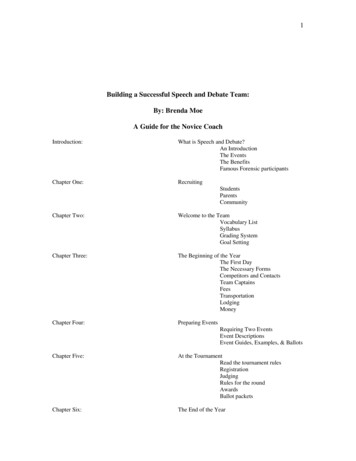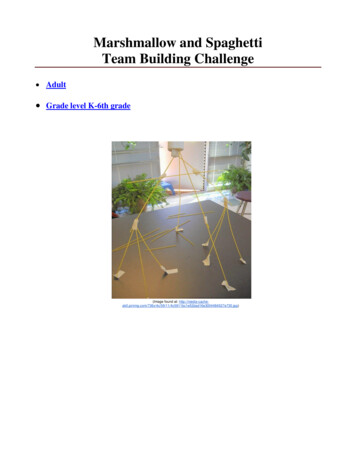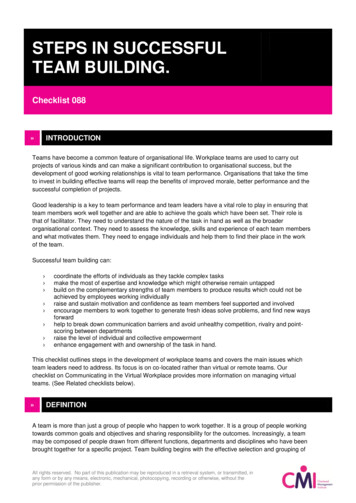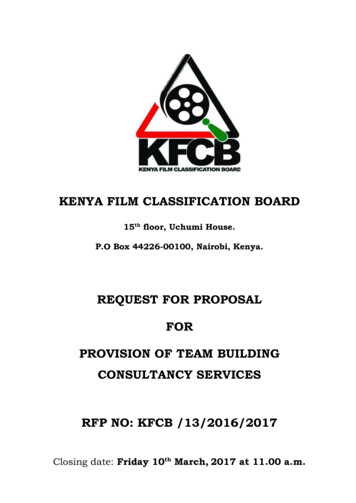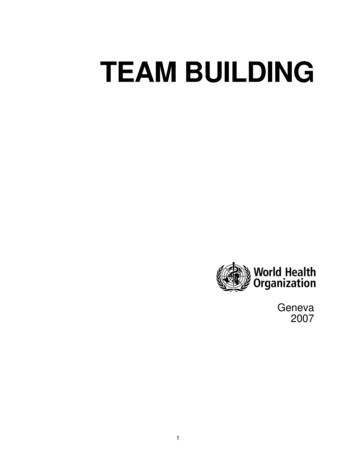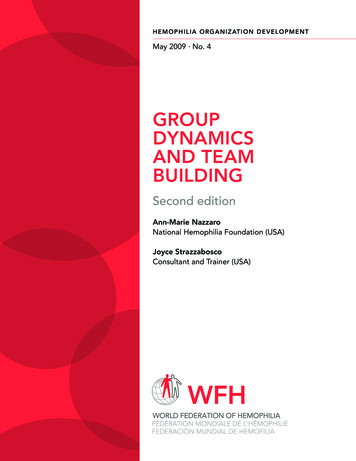
Transcription
HE M OP HI L I A OR G A N I Z AT I ON D E V E L OP M EN TMay 2009 · No. 4GROUPDYNAMICSAND TEAMBUILDINGSecond editionAnn-Marie NazzaroNational Hemophilia Foundation (USA)Joyce StrazzaboscoConsultant and Trainer (USA)
Published by the World Federation of Hemophilia (WFH), 2003; revised 2009 World Federation of Hemophilia, 2009The WFH encourages redistribution of its publications for educational purposes by not-for-profithemophilia organizations. In order to obtain permission to reprint, redistribute, or translate thispublication, please contact the Communications Department at the address below.This publication is accessible from the World Federation of Hemophilia’s web site at www.wfh.org,Additional copies are also available from the WFH at:World Federation of Hemophilia1425 René Lévesque Boulevard West, Suite 1010Montréal, Québec H3G 1T7CANADATel. : (514) 875-7944Fax : (514) 875-8916E-mail: wfh@wfh.orgInternet: www.wfh.orgThe Hemophilia Organization Development series aims to help hemophilia society leaders, staff, andvolunteers develop the skills necessary to effectively represent the interests of people with hemophilia.The World Federation of Hemophilia does not engage in the practice of medicine and under nocircumstances recommends particular treatment for specific individuals.Statements and opinions expressed here do not necessarily represent the opinions, policies, orrecommendations of the World Federation of Hemophilia, its Executive Committee, or its staff.
Table of ContentsIntroduction . 1Understanding Group Dynamics . 1Getting Acquainted . 2Clarifying Expectations . 3Group Problem Solving . 3Team Building . 4Team Development . 6Achieving Group Consensus . 6Conclusion . 7Resources . 7Appendix 1: Techniques for Managing Group Dynamics . 8Appendix 2: Building and Managing Successful Virtual Teams . 12Appendix 3: Broken Squares .Broken Squares Instruction Sheet for Participants.Instructions to the Observer/Judge .Directions for Making the Squares for the Broken Square Exercise .13141415Appendix 4: Team Stages . 16Appendix 5: Lost on the Moon . 17Actual NASA Ranking. 18
Group Dynamics and Team BuildingAnn-Marie Nazzaro, Joyce StrazzaboscoIntroductionUnderstanding Group DynamicsThis monograph was developed as a companionto a workshop on group dynamics and teambuilding, presented at the WFH Global NMOTraining Workshop May 16-18, 2002, in Huelva,Spain. The workshop offered two methods oflearning: (1) brief talks by the facilitators thatdescribed some theory, and (2) structuredactivities through which the participantsexperienced and then discussed some of theelements of group dynamics and team building.The term “group dynamics” refers to theinteractions between people who are talkingtogether in a group setting. Group dynamics canbe studied in business settings, in volunteersettings, in classroom settings, and in socialsettings. Any time there are three or moreindividuals interacting or talking together, thereare group dynamics.In this monograph, we will review some of thetheories of group dynamics and team buildingthat were addressed in that workshop. Inaddition, we have included structured activitiesthat may be used in local group settings. Itwould be advisable to identify a volunteer whohas some experience in managing groupdynamics to facilitate the activities.We wish to acknowledge that the content of thismonograph is taken from materials and theoriesdeveloped in the United States. Therefore, itreflects a western European cultural context.Some human behaviours transcend culturaldifferences; others do not. The reader will be thebest judge of how relevant the material may befor his or her local group. We offer these ideasand exercises as tools to understanding andimproving the effectiveness of one’s own group;they are not intended to influence or replacereaders’ cultural traditions.The subjects of group dynamics and teambuilding are broad. One can study each of thesetopics for years and still have more to learn.There are many ways to approach each. A simpleInternet search will result in thousands of websites on either group dynamics or team building.These subjects are important because theyinfluence how productive a group or a teambecomes. By understanding group dynamicsand by doing some team building, a group canincrease how much it accomplishes.A great deal can be learned by observation. Ifone sits back quietly in a group ― any group ―one will begin to see certain behaviouralpatterns emerge. There will be at least oneperson who tends to take the lead inconversation, offering his or her thoughts andopinions freely. There will be at least oneperson who remains quiet, sometimes not evenappearing interested in the conversation. Theremay be someone who tends to interrupt otherpeople, someone who wants the conversation tomove along faster, or who wants to focus on adifferent subject. Another person may beconcerned about peoples’ feelings and may tryto make everyone feel equally welcome. Theseare only a few of the roles that people assumewithout even thinking about it when they are ina group setting.Group roles are largely determined by acombination of a person’s personality and his orher experience with group settings. A personwho is shy is more likely to sit back in a group.A person who is impatient is more likely to pushthe discussion ahead. A person who is veryconfident will offer more opinions. If such rolesare more or less pre-determined, how can thegroup dynamics be improved?The way a group interacts can be improved inseveral ways. There are training programs toattend and there are tests one can take to learnabout one’s communication style. Perhaps thesimplest way to improve a group’s dynamics isfor one or more group members to learn tomanage the discussion, and thus help a groupaccomplish its goals, much as a conductor
2manages the many players in an orchestra toproduce a blended sound. By “manage” wemean respond to and redirect the behaviour orparticipation of an individual to a direction thatis better for the group. Whether or not the groupis managed, group roles will occur. By learningabout the typical kinds of behaviour that emerge,and how to respond to them appropriately,one can improve the effectiveness of groupdiscussions. [See Appendix 1: Techniques forManaging Group Dynamics.]The two most common roles affecting a group’seffectiveness are the person who dominates andthe person who remains silent. It can be asdifficult to get the quiet person to speak as it isto get the talkative person to talk less. Tomanage the dominant person, one might saysomething like, “You have a lot of good ideas,Carlos. I have written them down to discusslater. For now, we need to talk about .”To the quieter person, one might say, “What areyour thoughts on this subject, Marie?” It is bestto ask the quieter person a question that cannotbe answered by a simple “yes” or “no.” A broadquestion “casts a wider net,” to use a fishinganalogy. In any case, a direct and respectfulapproach is recommended where possible.(Note: In some cultures, directness is notappropriate. In some cultures, directness isacceptable, but only between certain types ofpeople. This is an example of when a readermay have to “translate” a suggested behaviourinto his or her own culture.)There are a variety of other roles that mayemerge in a group, and a textbook on groupdynamics would be a good resource for learningmore about them. In addition to beinginfluenced by culture, roles are influenced bygender, age, race/ethnicity, religious tradition,and other traits. For most people, though, it issufficient to know that group settings do bringout certain behaviours, and an effective group isone in which those behaviours are channeledpositively to move the agenda forward.Finally, one should be aware that themanagement of group dynamics can emergefrom any group member. The person with theauthority to lead (the chairperson or groupconvener) may not be the person who is best atactually managing group dynamics. Any groupmember who sees an opportunity should seizeGroup Dynamics and Team Buildingthe opportunity to improve the effectiveness ofthe members’ interactions. The entire group isresponsible for its own effectiveness and allmembers share equally in that responsibility.The chairperson or convener has agreed toperform certain duties, but it should not beassumed that he or she is the sole leader. Indeed,we will see below in the section on teambuilding that an effective group or team is one inwhich each member assumes responsibilityaccording to his or her talents and expertise.Getting AcquaintedSince group dynamics and team building arebased fundamentally on the relationshipsamong the people involved, it is both courteousand sensible to assure that the members all areintroduced to each other, and that they areoffered opportunities to get to know each otherand to build relationships. A group or team withmembers who know each other well is likely tobe more effective. People tend to offer more ofthemselves when they are with people whomthey know than when they are with strangers. Itis therefore a good idea to spend some timehelping people get acquainted with one another.Often we assume people know each other whenthey do not. A common feeling amongnewcomers is that the more senior members ofthe group are somewhat exclusive. This isbecause the senior members know each otherbetter and have well-established patterns ofcommunication. They have past experiences incommon and they may forget to explain certainreferences to the newcomers. This can lead to afeeling of exclusion, and if it is not corrected, thenewcomers might leave the group.It is the responsibility of the current members tohelp the newcomers get oriented to the groupand to its members. There are many ways toaccomplish this. People have created activitiescalled “Ice Breakers” or “Get-AcquaintedActivities.” A search on the Internet using eitherof those terms will produce many examples.These simple games can get people interactingwith each other.One popular ice-breaker is to divide the groupinto pairs, and have one person interview theother for a few minutes, and then switch.
Group Dynamics and Team BuildingSometimes an outline is given for the interviewquestions. Then the group is called backtogether, and each person introduces his or herpartner to the whole group. Individuals learn abit about the importance of listening when theybegin to introduce their partners. They alsolearn something about the various members ofthe group. Many find it easier to talk aboutsomeone else than to talk about themselves in alarge group. The timing for this exercise is about5 minutes for the interviews, and 30-60 secondsfor each introduction.Simpler still is to begin each meeting by askingthe members to introduce themselves, and tospecify at least part of what they should talkabout, with the leader or the chairperson goingfirst to set an example. Below is a list of somesuggested topics for introduction: Tell your name, how long you have beeninvolved with the group, and how youbecame involved with this group.Introduce yourself and tell us where yougrew up.Introduce yourself and tell us a valuable lifelesson that you have learned, such as:- What you think your greatest strength is;- A funny thing that happened to you;- When you first learned about ourorganization;- The farthest away you have ever traveled,and why you went there; and- One thing you hope we accomplish in thenext six months.The more one gets to know another person, themore he or she will understand that person. Thebetter people understand each other, the moreeffectively they can work together. Taking fiveto ten minutes to get acquainted at thebeginning of a meeting is a very soundinvestment of time.Clarifying ExpectationsUnderlyin
Group Dynamics and Team Building Ann-Marie Nazzaro, Joyce Strazzabosco Introduction This monograph was developed as a companion to a workshop on group dynamics and team building, presented at the WFH Global NMO Training Workshop May 16-18, 2002, in Huelva, Spain. The workshop offered two methods of learning: (1) brief talks by the facilitators that
